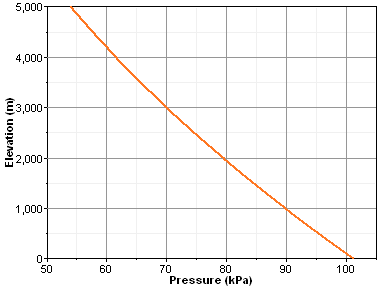
| Air Pressure |  |
The air pressure (also called atmospheric pressure, barometric pressure, or just pressure) is the force per unit area exerted against a surface by the weight of the air molecules above that surface. Windographer uses the air pressure to calculate the air density in each time step.
On the Data Columns tab of the Configure Dataset window you can identify one or more data columns as type 'air pressure' and specify their heights.
You can specify the primary pressure column for your dataset in the Configure Dataset window. Windographer uses the primary pressure column to calculate air density, and to compare temperature data across datasets, for example in the Diurnal Profile, Histogram, and Long Term Patterns windows.
Tip: The Column Display settings in the Configure Dataset window control how air pressure columns are displayed, including naming, order, and whether associated SD, max, and min columns appear.
Windographer calculates air density using the primary pressure column. If the dataset contains no measured air pressure data, or the primary pressure column contains no valid data for the time step in question, Windographer estimates air pressure according to the International Standard Atmosphere, using the following equation:

where: | ||
| p0 | is the standard atmospheric pressure at sea level [101.325 kPa] | |
| B | is the standard lapse rate [0.00650 K/m] | |
| z | is the elevation above mean sea level [m] | |
| T0 | is the standard sea-level temperature [288.15 K] | |
| g | is the acceleration due to gravity [9.81 m/s2] | |
| R | is the universal gas constant [287 J/kgK] |
The graph below plots this equation versus elevation:

If you have chosen to use the AWST pressure equation, then Windographer calculates the air pressure from elevation and temperature using the following equation:

where: | ||
| p0 | is the standard atmospheric pressure at sea level [101.325 kPa] | |
| T | is the measured temperature [K] | |
| z | is the elevation above mean sea level [m] | |
| g | is the acceleration due to gravity [9.81 m/s2] | |
| R | is the universal gas constant [287 J/kgK] |
If the height of the primary pressure sensor does not match the air density elevation then Windographer adjusts the measured air pressure values by adding to them a value of D p, given by the following equation:

where: | |
| z1 is the air density elevation [m] | |
| z2 is the elevation above sea level of the primary pressure sensor [m] | |
| p(z) is the pressure given by the International Standard Atmosphere equation (shown above) for elevation z [kPa] |
See also
Air Density Elevation definition
Standard Atmosphere tool window